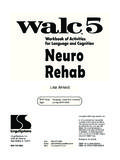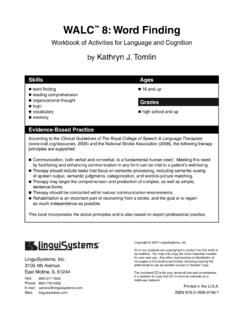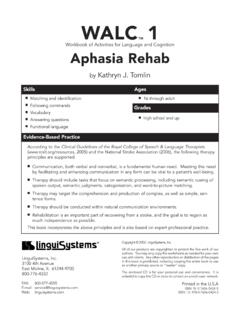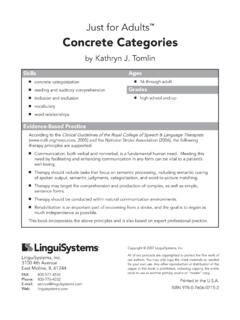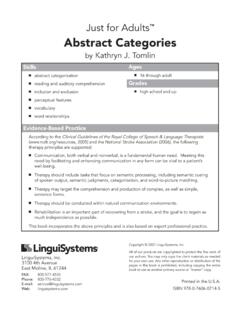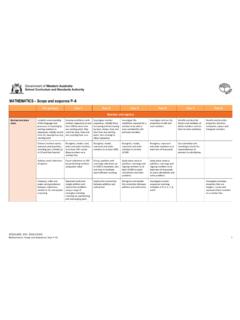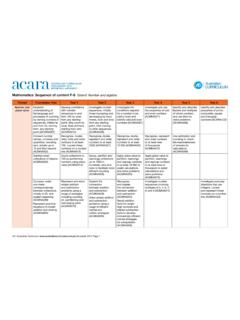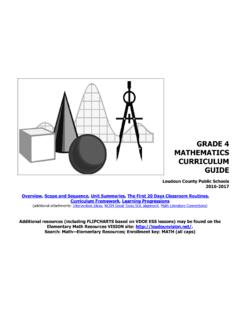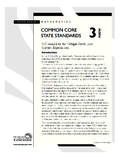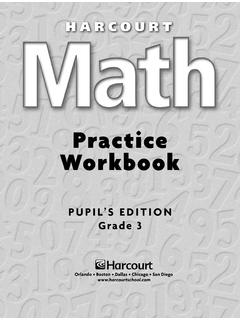Transcription of Kathryn J. Tomlin - Affiliated Rehab
1 Kathryn J. TomlinLinguiSystems, :1-800-577-45553100 4th AvenueE-mail: Moline, IL 61244-9700 IDEATDD:1-800-933-83311-800-776-4332(for those with hearing impairments)Copyright 2002 LinguiSystems, of our products are copyrighted toprotect the fine work of our this entire book for any reason is prohibited. You may, however, copy the worksheets for your clients as often as other reproduction or distributionof this book is not allowed, includingcopying this book to use as anotherprimary source or master in the 0-7606-0450-9 Skill Areas: language and cognitionAges:adolescents and adultsKathryn J.
2 Tomlin , , CCC-SLP, has been working with individuals with language and cognitive impairments since 1980. The exercises and techniques in this book have evolved through her experiences. She has worked as a speech-language pathologist in various settings. In addition to working and writing, Kathy is actively involved in missions work around the is a longtime author with LinguiSystems as WALC 2was originally published in 1984. Kathy is also the author of WALC 1, WALC 3, ACE 1, ACE 2, The Source for Memory Exercises, and The Source for Apraxia Therapy. She has also co-authored The Source for Group Language Therapy and two chapters in the book Minor Head Trauma, Springer-Verlag, New York.
3 Appreciation to all of the co-workers, friends, and clients who have used WALC 2and have provided me with many helpful suggestions during this book sdevelopment and growth stagesDedicationTo Howard and Jayne Tomlin in appreciation for their guidance in all my Photo by Wendy MoorePage Layout by Jamie HopeAbout the AuthorForewordMany years ago, when I began working with people with head injuries and neurological impairments, I was faced with the challenge of developing therapeuticmaterials for many areas and levels of language and cognitive retraining. As a resultWALC 2(Workbook of Activities for Language and Cognition) 2has gone through an evolution of improvement by way of client and fellowspeech-language pathologists who provided practical, hands-on suggestions.
4 You llfind that WALC 2is an excellent therapy supplement for trained professionals, clients families, and you use WALC 2, it is my sincere hope that all will benefit from using of 1: Attention and ..12 Subtraction ..15 Multiplication ..18 Division ..21 Mixed Math Problems ..24 Search Out Words ..27 Crossword Puzzles ..40 Seek Out Words ..48 Visual Scanning ..53 unit 2: Memory for General Information ..63 General Information Questions ..64 General Information Questions: Multiple Answers ..71 General Information Questions: Objects ..73 General Information Questions: Occupations.
5 74 General Information: Animals ..75 General Information: Food and Drink ..76 General Information: The United States ..77 General Information: Places ..78 General Information: People ..79 General Information: Important Days ..80 Yes/No Questions: General ..81 Yes/No Questions: Comparisons ..84 Yes/No Questions: Quantity ..85 unit 3: Visual and Auditory Words: Word Lists: Associated ..90 Chaining Word Lists: Varied ..91 Following Written/Oral Directions (1 step - 2 components) ..92 Following Written/Oral Directions (2 steps - 4 components) ..94 Following Written/Oral Directions (3 steps - 6 components).
6 96 Following Written/Oral Directions: Drawing Figures ..97 Word List Retention: Category Inclusion ..99 Word List Retention: Category Exclusion ..100 Word List Retention: Word Placement ..101 Word List Retention: Recall by Attribute ..103 Functional Memory: Memo ..104 Functional Memory: Appointments ..105 Functional Memory: Directions ..106 Functional Memory: Paragraph Manipulation: Opposites with a Manipulation: Math ..110 Mental Manipulation: Reverse Manipulation: Scrambled Manipulation: Word Progression ..113 Mental Manipulation: Alphabetical Order ..114 Mental Manipulation: Ranking.
7 115 Mental Manipulation: Largest Number ..116 Remembering Sentences ..117 Retention of a Paragraph ..120 unit 4: Sequential in the Letters ..144 Sentence Completions ..149 Story Completions ..154 Scrambled Words ..156 Scrambled Sentences ..160 Sequencing the Steps ..171 unit 5: Members Concrete ..182 Category Members Abstract ..185 Add to the Category Concrete ..187 Add to the Category Abstract ..189 State the Category Concrete ..191 State the Category Abstract ..193 Wrong Category Concrete ..194 Wrong Category Abstract ..197 Stating Logical Conclusions.
8 198 Problem Solving Answering Questions ..202 Similarities and Differences ..203 Object Description ..207 Opposites ..208 Definitions ..212 Multiple Definitions ..215 Describing with Attributes ..220 Inconsistencies in Sentences ..222 Constant Characteristics ..226 Analogies ..228 Word Deduction ..233 Proverbs and Expressions ..238 Written Directions ..243 Multiple Sentence Formulation ..249 Multiple Uses for Objects ..251 Stating Situational Problems ..252 Improving a Product or Event ..254 Improving an Institution or Situation ..256 Determining Consequences of Changes.
9 257 Stating an Item with an Imagined Improvement ..259 Positive and Negative Viewpoints ..261 Multiple Character Viewpoints ..263 Inferences About Paragraphs ..267 Deduction Puzzle #1 ..273 Deduction Puzzle #2 ..274 Deduction Puzzle #3 ..275 Deduction Puzzle #4 ..276 Deduction Puzzle #5 ..277 Deduction Puzzle #6 ..278 Answer 29 Copyright 2002 LinguiSystems, 2 was developed to provide stimulus materials to aid in the remediation of language and cognitive disorders in adolescents and adults. The items in this workbook provide a structured approach for improving specific skills in target areas,although adaptations may be necessary to meet each client s needs.
10 All exerciseswithin this workbook remediate a specific deficit, but also require skills in other areasof language and cognition in order to be completed 1: Attention and ConcentrationThis first unit of WALC 2 focuses on attention and concentration. Frequently, patients with neurological impairments exhibit difficulty in attending to or completing structured therapy tasks. These exercises enable the client to complete the tasks with minimal challenges to his cognitive 2: Memory for General InformationThis unit requires the use of remote memory skills in order to answer the general information questions elicit information from patients with various backgrounds, be aware of errors which occur as a result of a language or cognitive deficit versus responses which occur due to lack of familiarity with the targeted information or due to cultural factors.
